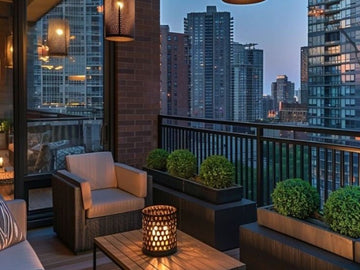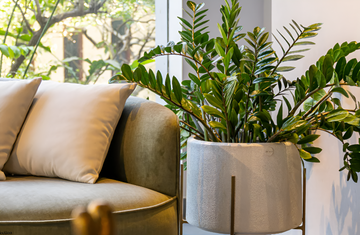Welcome to the green side of life! Indoor plants not only add beauty and freshness to our living spaces but also provide numerous benefits for our physical and mental health. And when it comes to providing the best planting care, worry not, as we've got you covered!
Top 10 Tips to Help You Take Care of Your Plants
Lighting | Right Potting Mix | Water Deeply | How to Fertilize | Rotate Your Plants | Dust Your Plant | Provide Plant Stability | Pruning | Natural Pest Control | Give Plant Fresh Air | Planter Recommendation
Look for the Best Lighting
Click on the image to buy
Providing the right lighting conditions is crucial for the health and growth of indoor plants. Most plants require bright, indirect light, but the intensity and duration of light exposure can vary based on the specific plant's needs.
South-facing windows typically provide the most light while north-facing windows may not provide enough light for many plants. Avoid placing plants in direct sunlight, as this can scorch the leaves. On the other hand, too little light can lead to stunted growth and yellowing leaves. If natural light is limited, artificial grow lights can be a good option. LED grow lights can provide the necessary spectrum of light for plants to thrive. Be sure to research the specific light requirements for each plant and adjust light exposure as needed.
Choose the Right Potting Mix
Choosing the right potting mix for your indoor plants is crucial for their overall health and well-being. A good potting mix should provide your plants with adequate drainage, nutrient retention, and oxygenation, all of which are essential for their growth and survival. Avoid using red soil in your indoor planter as it can be too heavy, retain too much moisture, and introduce pests and diseases to your indoor plants. Instead, choose a high-quality mix that's specifically designed for indoor plants. You can also create your own potting mix by mixing coco peat, perlite, and compost or organic fertilizers to make a balanced mix.
Water Deeply but Infrequently
Overwatering is a common mistake made by new plant owners. Instead, water them deeply but less frequently. This will help prevent root rot and ensure that your plant's roots are getting enough oxygen. The key to deep watering is to make sure that the soil is thoroughly moistened, and that the excess water drains out of the planter. Simply water your plants until the water starts to drain from the bottom of the planter or container, indicating that the soil has absorbed as much water as it can hold. Then, wait until the soil has dried out partially before watering again.
How to fertilize?
If you're unsure about fertilizing your houseplants, it's better to err on the side of caution and skip fertilization altogether. While fertilizer can provide essential nutrients that plants need to grow, too much of it can cause more harm than good. It's also important to note that some plants don't require fertilization at all or only need it during specific times of the year, such as during their active growing season.
Rotate Your Plants
Click on the image to buy
When you rotate your plants, you help to ensure that all sides of the plant receive equal exposure to light and air circulation. This is particularly important for plants that tend to grow towards the light source, as rotating them can help prevent uneven growth and promote more balanced development. Rotating your plants can also help prevent issues like pests and diseases, as it allows you to inspect all sides of the plant regularly and catch any problems early on.
Dust your Plants
Dust can accumulate on your plants' leaves, blocking sunlight and hindering photosynthesis. Use a soft, damp cloth to gently wipe down your plants' leaves every few weeks. If the plant has small or delicate leaves, you can also use a small paintbrush or makeup brush to brush away the dust gently.
Provide Stability to Your Plants
Click on the image to buy
To create a stable environment for your houseplants, start by selecting a location that provides consistent conditions in terms of light, temperature, and humidity. This might be a room that receives a similar amount of natural light throughout the day or a spot away from drafty windows or vents. It's also important to avoid sudden changes in environmental conditions. For example, moving your plant from a sunny window to a shady corner can shock the plant and cause stress. Similarly, sudden changes in temperature or humidity can also stress your plants.
Prune Regularly
Pruning is a crucial aspect of indoor plant care that involves cutting back stems, branches, and leaves. It helps maintain the size and shape of plants, encourages bushier and compact growth, and removes dead or diseased parts to improve overall health. Pruning also promotes airflow and light penetration, reducing the risk of fungal growth, and can stimulate new growth and flowering. Clean and sharp tools are essential, and over-pruning should be avoided as it can weaken the plant. Regular pruning is crucial for maintaining healthy, attractive indoor plants.
Use Natural Pest Control
Pests can quickly spread among indoor plants, so it is important to use natural pest control methods like neem oil spray to keep pests at bay. Using neem oil can be effective without harming beneficial insects or the environment. Neem oil can be applied topically to plants or added to the soil to control soil-borne pests. It can also be used preventively to help prevent pest infestations.
Give Your Plants Some Fresh Air
Click on the image to buy
Indoor plants can benefit from a breath of fresh air every now and then. On mild days, open a window or take your plants outside for some fresh air and sunlight. This is important for their overall health and well-being. Plants need fresh air to help regulate temperature and humidity, exchange gases and remove harmful pollutants from their environment. Lack of fresh air can lead to stagnant air and increased levels of carbon dioxide, which can negatively impact plant growth and health.
And there you have it - our top 10 tips for taking care of your indoor plants like a pro! By following these simple guidelines, you'll be able to create a beautiful and thriving indoor garden that brings joy and freshness to your living space. Remember, plant care is not just about providing water and light; it's about creating a nurturing environment that supports your plants' growth and well-being. So, don't be afraid to experiment, learn from your mistakes, and enjoy the process of watching your green babies flourish. Happy planting!
Discover more planters for your Indoor Plants
View Here
References & Credits



















 At Palasa, we believe in the seamless fusion of nature, design and humanity.
At Palasa, we believe in the seamless fusion of nature, design and humanity.